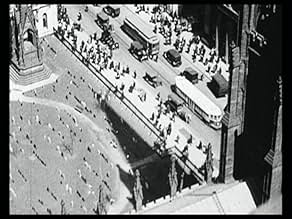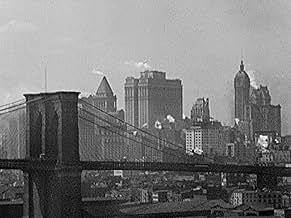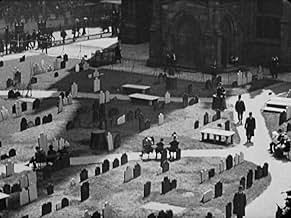AVALIAÇÃO DA IMDb
6,6/10
1,7 mil
SUA AVALIAÇÃO
Adicionar um enredo no seu idiomaThis groundbreaking silent documentary captures the beauty and majesty of the New York City in its streets, skyscrapers, bridges, rail yards and harbors.This groundbreaking silent documentary captures the beauty and majesty of the New York City in its streets, skyscrapers, bridges, rail yards and harbors.This groundbreaking silent documentary captures the beauty and majesty of the New York City in its streets, skyscrapers, bridges, rail yards and harbors.
- Direção
- Roteirista
- Prêmios
- 1 vitória no total
Avaliações em destaque
Manhatta (1921)
**** (out of 4)
Cinematographer Paul Strand and painter Charles Sheeler teamed up to make this movie, which was their attempt to show their love for the city of Manhattan. The say they achieved in showing that love would be an understatement because this 11-minute movie is extremely well-made and contains some downright break taking visuals. The semi-documentary film has various images of the city put together in no real order nor do they try to tell a story out of the images. Instead we just see various items from the city, ranging from haze rising over buildings to various ships on the water. All of these images make for an incredible film because it really seems like you're watching a science-fiction film with a bunch of fake images. It's rather amazing at how well the cinematography is here because unlike many, or perhaps any film, this one here puts you so close to what you're looking at that it's nearly impossible to remember you're watching a movie. This is certainly one of the most beautiful looking films I've seen and perhaps the start of what would become avant-garde film and one has to wonder if Stanley Kubrick saw this and learned from it.
**** (out of 4)
Cinematographer Paul Strand and painter Charles Sheeler teamed up to make this movie, which was their attempt to show their love for the city of Manhattan. The say they achieved in showing that love would be an understatement because this 11-minute movie is extremely well-made and contains some downright break taking visuals. The semi-documentary film has various images of the city put together in no real order nor do they try to tell a story out of the images. Instead we just see various items from the city, ranging from haze rising over buildings to various ships on the water. All of these images make for an incredible film because it really seems like you're watching a science-fiction film with a bunch of fake images. It's rather amazing at how well the cinematography is here because unlike many, or perhaps any film, this one here puts you so close to what you're looking at that it's nearly impossible to remember you're watching a movie. This is certainly one of the most beautiful looking films I've seen and perhaps the start of what would become avant-garde film and one has to wonder if Stanley Kubrick saw this and learned from it.
Preface: Due to the nature of such a short film, any valid review will contain some evidence of a "spoiler." This review is no exception.
Paul Strand's "Manhatta" is more than just the simple, pioneering piece in early cinema. "Manhatta" is a representation of New York City through the eyes of a still photographer. Strand uses the format of motion picture to create a sense of life. Similar to his New York still photography, each moving image frames city life, angles, and other objects with semi-avant-garde detail. Strand's own "mentor," Alfred Stieglitz, greatly appreciated the new form of city photography, publishing it in "Camera Work" and in his gallery 291.
In the movie, the blowing smoke, walking people, moving ships, and other objects in motion are what separate the motion picture from a photo album. Instead of portraying New York as an iconic, prosperous city, Strand has been able to portray New York City as an organism that contains a immigrant working class.
In my opinion, "Manhatta" commands the respect of many early motion pictures, influencing many great, more popular films.
Paul Strand's "Manhatta" is more than just the simple, pioneering piece in early cinema. "Manhatta" is a representation of New York City through the eyes of a still photographer. Strand uses the format of motion picture to create a sense of life. Similar to his New York still photography, each moving image frames city life, angles, and other objects with semi-avant-garde detail. Strand's own "mentor," Alfred Stieglitz, greatly appreciated the new form of city photography, publishing it in "Camera Work" and in his gallery 291.
In the movie, the blowing smoke, walking people, moving ships, and other objects in motion are what separate the motion picture from a photo album. Instead of portraying New York as an iconic, prosperous city, Strand has been able to portray New York City as an organism that contains a immigrant working class.
In my opinion, "Manhatta" commands the respect of many early motion pictures, influencing many great, more popular films.
10DaveLB-3
Instead of having a filmmaker attempting to be painterly, this poetic gem boasts both a major painter (Sheeler) and a major photographer (Strand) collaborating.
This is the earliest view of Manhattan we have that is neither simple-minded documentation nor backdrop to melodrama. The visuals are striking, and stand up well to later, more gimmicky, film realizations of what makes Skyscraper National Park so special.
The Walt Whitman title cards would probably have worked better as voiceover narration in the sound era, but offer a strong romantic framework for the powerful imagery. A classic, not to be missed.
This is the earliest view of Manhattan we have that is neither simple-minded documentation nor backdrop to melodrama. The visuals are striking, and stand up well to later, more gimmicky, film realizations of what makes Skyscraper National Park so special.
The Walt Whitman title cards would probably have worked better as voiceover narration in the sound era, but offer a strong romantic framework for the powerful imagery. A classic, not to be missed.
MANHATTA is an unusual short film. It's like the merging of a travelogue with a poem. So, as the camera moves artistically about the city of New York, the scenes are punctuated with intertitle cards that have poetic verse on them that make it all seem grand and majestic.
While much of this won't appeal to most viewers, the film is still worth seeing for two important reasons. First, the short is a wonderful historical record of the city. In other films of the era, New York is incidental, in a way. You might see bits and pieces of the city, but the city is not the star. Here, however, you see so much of the town that you wouldn't see otherwise--and much of it is gone today. Second, the film is very artistic in its cinematography--with wonderful aerial shots as well as nicely frames shots of the Brooklyn Bridge and the like.
Perhaps not exciting, but a rather important document. And, despite the original negatives being missing and only one print in existence until it was restored, the print looks great!
While much of this won't appeal to most viewers, the film is still worth seeing for two important reasons. First, the short is a wonderful historical record of the city. In other films of the era, New York is incidental, in a way. You might see bits and pieces of the city, but the city is not the star. Here, however, you see so much of the town that you wouldn't see otherwise--and much of it is gone today. Second, the film is very artistic in its cinematography--with wonderful aerial shots as well as nicely frames shots of the Brooklyn Bridge and the like.
Perhaps not exciting, but a rather important document. And, despite the original negatives being missing and only one print in existence until it was restored, the print looks great!
This groundbreaking silent documentary captures the beauty and majesty of the New York City in its streets, skyscrapers, bridges, rail yards and harbors.
Is this film groundbreaking? I would have to agree with that. But unfortunately, it doesn't break nearly as much ground as it could. The film reminds me of "Berlin", the documentary made by Karl Freund and Carl Mayer, among others. The big difference being that "Manhatta" is not particularly long.
And that is why I can only give it so much love, because I wish more of 1920s New York was captured on film, an era that is still remembered fondly today (2017). Any document would be somewhat priceless to the right people.
Is this film groundbreaking? I would have to agree with that. But unfortunately, it doesn't break nearly as much ground as it could. The film reminds me of "Berlin", the documentary made by Karl Freund and Carl Mayer, among others. The big difference being that "Manhatta" is not particularly long.
And that is why I can only give it so much love, because I wish more of 1920s New York was captured on film, an era that is still remembered fondly today (2017). Any document would be somewhat priceless to the right people.
Você sabia?
- CuriosidadesThe poet whose works are quoted during the film is Walt Whitman.
- Citações
Title Card - Walt Whitman: "City of the world - for all races are here, City of tall facades of marble and iron, Proud and passionate city."
- Versões alternativasThis film was published in Italy on an DVD anthology entitled "Avanguardia: Cinema sperimentale degli anni '20 e '30", distributed by DNA Srl. The film has been re-edited with the contribution of the film history scholar Riccardo Cusin . This version is also available in streaming on some platforms.
- ConexõesFeatured in The Secret Life of Sergei Eisenstein (1987)
Principais escolhas
Faça login para avaliar e ver a lista de recomendações personalizadas
Detalhes
- Tempo de duração
- 11 min
- Cor
- Mixagem de som
- Proporção
- 1.33 : 1
Contribua para esta página
Sugerir uma alteração ou adicionar conteúdo ausente





















